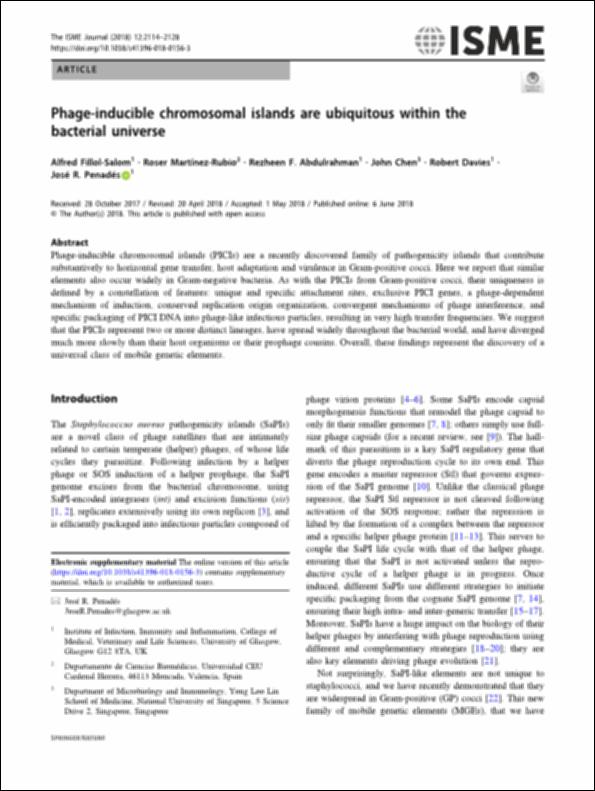Por favor, use este identificador para citar o enlazar este ítem:
http://hdl.handle.net/10637/9993Phage-inducible chromosomal islands are ubiquitous within the bacterial universe
| Título : | Phage-inducible chromosomal islands are ubiquitous within the bacterial universe |
| Autor : | Fillol Salom, Alfred Martínez Rubio, Roser Abdulrahman, Rezheen F. Chen, John Davies, Robert Penadés Casanova, José Rafael |
| Materias: | Genética bacteriana.; Immunology.; Microbiología médica.; Medical microbiology.; Bacterias patógenas.; Pathogenic bacteria.; Gram-Negative Bacteria.; Microorganismos patógenos.; Pathogenic microorganisms.; Bacteriología médica.; Medical bacteriology.; Estafilococos.; Staphylococcus.; Bacterias Gram-Negativas.; Inmunología.; Bacterial genetic. |
| Editorial : | Springer |
| Citación : | Fillol-Salom, A., Martínez-Rubio, R., Abdulrahman, RF., Chen, J., Davies, R. and Penadés, JR. (2018). Phage-inducible chromosomal islands are ubiquitous within the bacterial universe. The ISME Journal, vol. 12, n. 9 (jun.), pp. 2114-2128. DOI: https://doi.org/10.1038/s41396-018-0156-3 |
| Resumen : | Phage-inducible chromosomal islands (PICIs) are a recently discovered family of pathogenicity islands that contribute substantively to horizontal gene transfer, host adaptation and virulence in Gram-positive cocci. Here we report that similar elements also occur widely in Gram-negative bacteria. As with the PICIs from Gram-positive cocci, their uniqueness is defined by a constellation of features: unique and specific attachment sites, exclusive PICI genes, a phage-dependent mechanism of induction, conserved replication origin organization, convergent mechanisms of phage interference, and specific packaging of PICI DNA into phage-like infectious particles, resulting in very high transfer frequencies. We suggest that the PICIs represent two or more distinct lineages, have spread widely throughout the bacterial world, and have diverged much more slowly than their host organisms or their prophage cousins. Overall, these findings represent the discovery of a universal class of mobile genetic elements. |
| Descripción : | En The ISME Journal. Heidelberg (Germany): Springer. Vol. 12, n. 9, pp. 2114-2128 (2018). Este artículo se encuentra disponible en la página web de la revista en la siguiente URL: https://www.nature.com/articles/s41396-018-0156-3 |
| URI : | http://hdl.handle.net/10637/9993 |
| Derechos: | http://creativecommons.org/licenses/by/4.0/deed.es |
| ISSN : | 1751-7362. 1751-7370 (Electrónico). |
| Fecha de publicación : | 16-jun-2018 |
| Centro : | Universidad Cardenal Herrera-CEU |
| Aparece en las colecciones: | Dpto. Ciencias Biomédicas |
Los ítems de DSpace están protegidos por copyright, con todos los derechos reservados, a menos que se indique lo contrario.


